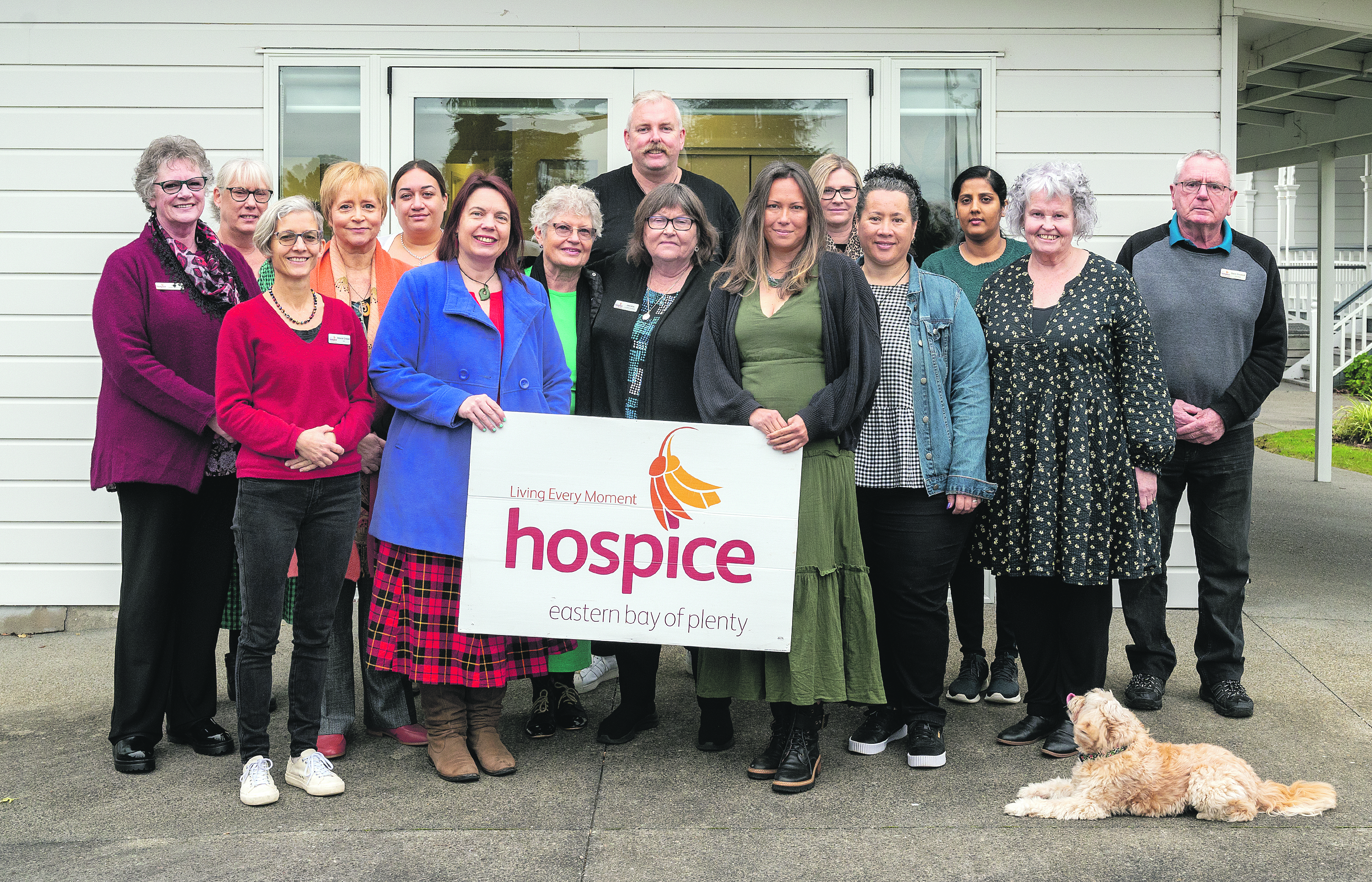Hospice EBOP refreshes and regroups

FUTURE IS BRIGHT: Hospice EBOP’s experienced team, with many new faces, from left, Julie Tucker-Bennett, Brigit Billings, Deb Crossan, Shelly Moloney, Jamie-Lee Fraser-Jones, Rachel Shouler, Jossie Crous, Bryce Sheedy, Jane Kay, Lydia Tulip, Laura Cannon, Sonya Moulden, Josephine James, Catherine Grieg, Gavin Shadbolt and Scout the dog. Photo Troy Baker E4801-04
Kathy Forsyth
WITH a fresh team on board, Hospice EBOP is embracing a new service – and people-focused direction.
Chief executive Bryce Sheedy, who has been in the role for six months, is pleased with the numerous changes already made.
Since January, a fresh leadership team has been appointed, including Mr Sheedy and new board chair Toni Owen. After years of struggling to appoint nurses, the hospice now has a full team.
“When I started, there were issues hiring nurses, but we have changed our focus, and gone from having three clinical staff to eight,” said Mr Sheedy.

The team now includes three registered nurses, three clinical nurse specialists, a doctor, a clinical lead, and there is a social worker. They were welcomed at a pōhiri yesterday.
Mr Sheedy praised the nurses for their remarkable work and strong connections with patients and their whānau.
“What they do is amazing. Watching the nurses come back and talk about the patients and the connections whānau have with them is remarkable and fuels my passion for hospice.”
Rachel Shouler is the new doctor, although hospice’s financial constraints limit her to 15 hours a week.
The hospice is funded 48 percent by Te Whatu Ora and must raise an additional $380,000 to $480,000 this year.
“In the past few years, we probably didn’t know what it cost to run it because the hospice didn’t have the staff or community connection, and the hospital’s palliative care response team was doing half the work,” Mr Sheedy said.
But he said the board had been super supportive of its new direction.
Hospice EBOP has faced challenges over the past six to seven years, including resignations and disputes under former chief executive Peter Bassett.
An independent review released last year criticised the hospice’s poor service delivery.
Whakatāne Hospital established its own interim Palliative Care Response Team to reduce referrals to Hospice EBOP. However, the disbandment of the hospital’s palliative team signals renewed confidence in Hospice EBOP.
“We are now back to being the primary palliative care service,” he said.
“We have come a long way in six months and are probably six months ahead of where I thought we would be.
“It is has not been an easy road: “We have a bit of work to do in gaining trust in some spaces.”
The organisation is also becoming more culturally aware, with support from Amohaere Tangitu, who has pioneered change in health care, particularly for Māori.
Small changes, such as switching to a local IT provider, reflect the hospice’s commitment to the Eastern Bay.
Mr Sheedy and volunteer Jane Kay regularly speak at clubs and organisations, such as Lions and Rotary, reaching over 1000 people so far.
The hospice has shifted from a business model to more of a service model.
“Resources are focused on the clinical team.”
Despite challenges, including poor phone coverage in 40 percent of its service area and the huge geographical area the hospice covers, driving about 14,000 kilometres a month, the team has increased its patient load by 20 percent.
“We sit around the mid-60s with patients at any time, partly because we have taken back the patients from the hospital team.
“And we could still do with another one or two nurses.”
Experienced staff have returned, and the hospice culture has transformed.
“People are our core business. I am confident we are on the right track.
“Anything to do with people comes down to relationships, so it is how you support and empower people, and we are empowering the people who are already here,” Mr Sheedy said.
He also wants the workplace to be a fun, enjoyable environment.
“We are dealing with high emotions all the time, so having fun is good. Everyone looks after each other.
“As we grow there are going to be bumps in the road, but it is how you deal with those bumps, and I think the goal is to deal with those bumps in a way that upholds people’s mana.”
Volunteers play a crucial role, and the hospice is always seeking more, including board members from diverse areas.
New fundraising initiatives, such as sponsorships on hospice cars, aim to streamline efforts.
“I think it is important to focus on our core business and not move resources away from patients.”
Mr Sheedy emphasises that every decision prioritises patient care.
“If it doesn’t make it better for our patients, we don’t do it.”
He is proud of the team’s dedication and is optimistic about the future.
“We have the most experienced team in years, all committed to making a difference in palliative care,” he said.
“Everyone is here because they want to work in palliative care and make a difference.
“Our admin and comms team have really stepped up. Everyone is empowered and supported to do their job.”